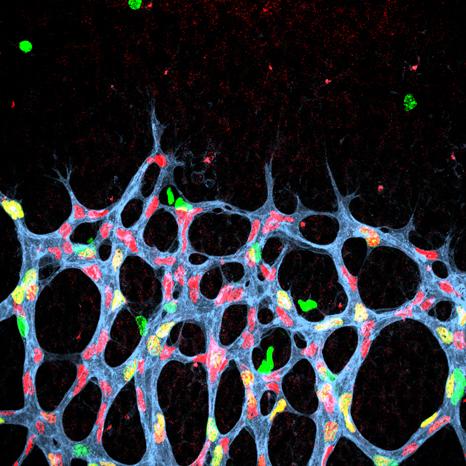Caring for blindness: A new protein in sight?

Growth is upward. The endothelial cells constituting the vessel walls are shown in blue and their nuclei in red. Green staining indicates the nuclei of proliferating cells, which will give rise to new vessels. Proliferating endothelial cells therefore appear yellow (green added to red). Credit: © Alain Chédotal / Inserm
Vasoproliferative ocular diseases are the main cause of blindness in the industrialised countries. Age-related macular degeneration (ARMD), diabetic retinopathy and retinopathy of prematurity (in newborns) are characterised by progressive involvement of the retina, the area of the eye that receives visual information and transmits it to the brain.
This damage is caused by abnormal growth of the blood vessels in the retina. These weakened vessels allow leakage of serum–which causes a swelling that lifts the retina–and/or blood, which leads to retinal haemorrhage.
This process involves several proteins required for normal or pathological development of the blood vessels. The action of vascular endothelial growth factor (VEGF) is a particularly decisive factor in this ocular disorder. At present, the main treatments are aimed at blocking its action by injecting inhibitors into the eye. Some patients are or become resistant to these anti-VEGF therapies.
For this reason, the team led by Alain Chédotal, in collaboration with a team led by Anne Eichmann , sought to identify new factors involved in the growth of new blood vessels, angiogenesis. They paid particular attention to Slit2.
Slit2 is a protein already known for its role in the development of neural connections. By acting on its receptors, Robo1 and Robo2, it is also involved in the development of many organs and certain cancers. The researchers therefore formulated the hypothesis that this factor might have a role in the abnormal vascularisation observed in vasoproliferative ocular diseases.
To test this postulate, the scientists inactivated Slit2 in a mouse model. They observed that ramification and growth of the retinal blood vessels were severely reduced, without any change in the stability of the pre-existing blood supply. Surprisingly, they discovered that without this protein, VEGF action was also partly reduced. By simultaneously blocking Robo1 and Robo2, they obtained the same results. They thus demonstrated that Slit2 is essential for angiogenesis in the retina.
“The success of these initial experiments led us to hope that controlling Slit2 might block the chaotic development of blood vessels in ocular diseases,” explains Alain Chédotal, Inserm Research Director.
The team therefore repeated these tests in an animal model for retinopathy of prematurity. As they had suspected, the absence of Slit2 protein prevented abnormal vascularisation of the retina in these young mice.
This work suggests that therapies targeting Slit2 protein and its receptors, Robo1 and Robo2, might be beneficial for patients with vasoproliferative ocular disease, especially those who are resistant to conventional anti-VEGF therapies.
Moreover, it would be interesting to set up other studies to obtain a better understanding of the mechanism of action of Slit2 and its relationship with VEGF. This could open up new avenues for the treatment of tumours.
###
Sources
Slit2 signaling through Robo1 and Robo2 is required for retinal neovascularization. Nicolas Rama1-3,8, Alexandre Dubrac4,8, Thomas Mathivet5, Róisín-Ana Ní Chárthaigh1-3, Gael Genet4, Brunella Cristofaro5, Laurence Pibouin-Fragner5, Le Ma6, Anne Eichmann4,5,7 and Alain Chédotal1-3
1 INSERM Joint Research Unit S968, Vision Institute, Paris, France.
2 Pierre and Marie Curie University, Sorbonne Universities, Paris, France.
3 Joint Research Unit 7210, CNRS, Paris, France.
4 Section of Cardiovascular Medicine, Department of Internal Medicine, Yale Cardiovascular Research Center, Yale University School of Medicine, New Haven, Connecticut, USA.
5 Centre for Interdisciplinary Research in Biology (CIRB), Collège de France, Paris, France.
6 Department of Neuroscience, Farber Institute for Neurosciences, Thomas Jefferson University, Philadelphia, Pennsylvania, USA.
7 Department of Cellular and Molecular Physiology, Yale University School of Medicine, New Haven, Connecticut, USA.
8 These authors contributed equally to this work.
Nature Medicine, 17 April 2015
Investigator contact
Alain Chédotal
Inserm Research Director
Inserm Unit 968 “Vision Institute”
+33 (0) 1 53 46 25 15
alain.chedotal@inserm.fr
Press contact
Access the Inserm press room: presse-inserm.fr/en/
The press release in english : http://presse-inserm.
In french : http://presse-inserm.
Media Contact
All latest news from the category: Health and Medicine
This subject area encompasses research and studies in the field of human medicine.
Among the wide-ranging list of topics covered here are anesthesiology, anatomy, surgery, human genetics, hygiene and environmental medicine, internal medicine, neurology, pharmacology, physiology, urology and dental medicine.
Newest articles

NASA: Mystery of life’s handedness deepens
The mystery of why life uses molecules with specific orientations has deepened with a NASA-funded discovery that RNA — a key molecule thought to have potentially held the instructions for…

What are the effects of historic lithium mining on water quality?
Study reveals low levels of common contaminants but high levels of other elements in waters associated with an abandoned lithium mine. Lithium ore and mining waste from a historic lithium…

Quantum-inspired design boosts efficiency of heat-to-electricity conversion
Rice engineers take unconventional route to improving thermophotovoltaic systems. Researchers at Rice University have found a new way to improve a key element of thermophotovoltaic (TPV) systems, which convert heat…



